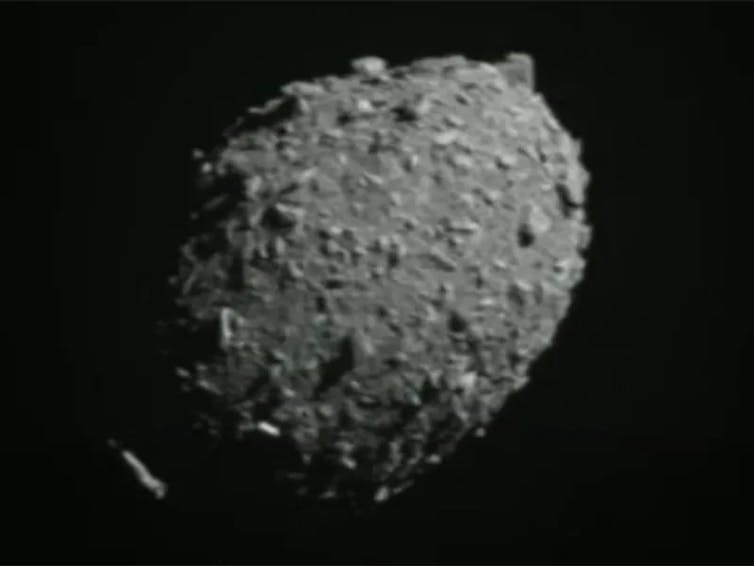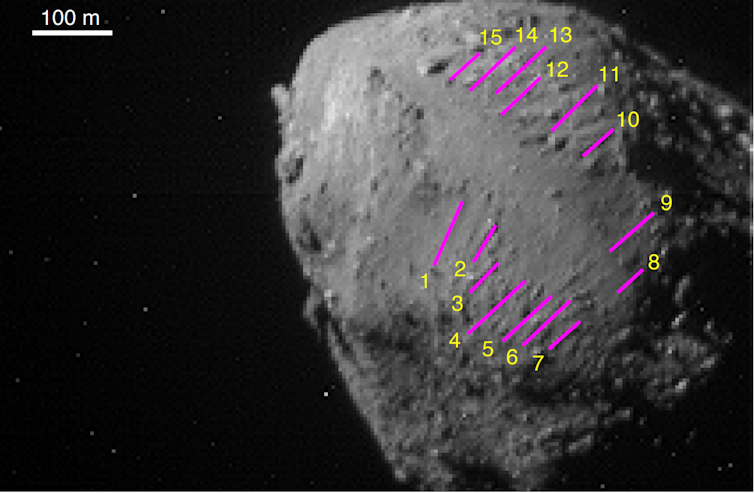NASA’s DART mission – the Double Asteroid Redirection Test – was humanity’s first true planetary defense mission.
In September 2022, the DART spacecraft will hit the companion “moon” of a small asteroid 11 million kilometers from Earth. One of its goals was to find out if we could push something like that away from us.
Collecting a lot of data about the approach to Earth and after the collision will give us a better idea of what consequences we might have to face if such an asteroid hits the Earth.
Five new studies published today in Nature Communications trace the origins of the Didymos-Dimorphos double asteroid system using images sent back from DART and its traveling companion LICIACube. They also put that data in the context of other asteroids.

Asteroids are natural hazards
Our solar system is filled with small asteroids – debris that never reached the planets. Those that come close to Earth’s orbit around the sun are called Near Earth Objects (NEOs). These pose the greatest threat to us, but are also the most accessible.
Planetary safety from these natural disasters really depends on knowing their composition – not just what they are made of, but how they are put together. Are they solid objects that could penetrate our atmosphere if given the chance, or are they more like piles of rubble, barely held together?
The asteroid Didymos and its smaller moon Dimorphos are known as a binary asteroid system. They were the perfect targets for the DART mission, because the effects of an impact could easily be measured in changes to Dimorphos’ orbit.
They are also very close to Earth, or at least NEOs. And they are a very common type of asteroid that we have not observed well before. There was also the chance to learn how binary asteroids form, which was the icing on the cake.
Many binary asteroid systems have been discovered, but planetary scientists don’t know exactly how they form. In one of the new studies, a team led by Olivier Barnouin of Johns Hopkins University in the United States used images from DART and LICIACube to estimate the age of the systems by looking at surface roughness and crater records.
They found that Didymos is about 12.5 million years old, while its moon Dimorphos formed less than 300,000 years ago. That might still seem like a lot, but it’s much younger than expected.
pile of stones
Dimorphos is also not solid rock as we usually think of it. It is a rubble pile of rocks that are barely held together. Combined with its young age, this suggests that there may be several “generations” of these rubble pile asteroids in the wake of large asteroid collisions.
Sunlight actually causes smaller bodies like asteroids to spin. As Didymos began spinning like a top, its shape became squashed and bulged in the middle. This was enough to cause large pieces to roll off the main body, and some even left traces.
These pieces gradually formed a ring of debris around Didymos. Over time, when the debris began to stick together, it led to the formation of the smaller moon Dimorphos.
Another study led by Maurizio Pazzola of Auburn University in the US used boulder distribution to confirm this. The team also found that there were significantly more (up to five times) large boulders than those seen on other non-binary asteroids observed by humans.
One of the new studies also shows that all the rocks on the asteroids observed by space missions so far (Itokawa, Ryugu and Bennu) are probably of similar size. But this excess of large rocks on the Didymos system may be a unique feature of the binary.

Finally, another paper suggests that this type of asteroid is more likely to crack. This is due to the heating-cooling cycles between day and night: like the freeze-thaw cycle but without the water.
This means that if something (such as a spacecraft) hits it, a lot more debris will be thrown into space. This will also increase the amount of “push”. But there’s a good chance that what’s down there is much more powerful than what we’re seeing on the surface.
This is where the European Space Agency’s Hera mission will come in. It will not only be able to provide high-resolution images of DART impact sites, but also probe the interiors of asteroids using low-frequency radar.
The DART mission not only tested our ability to protect ourselves from future asteroid impacts, but also gave us insight into the formation and evolution of near-Earth debris plumes and double asteroids.![]()
,Author: Eleanor K. Sansom, Research Associate, Curtin University)
,disclosure statement: Eleanor K. Sansom receives funding from the International Centre for Radio Astronomy Research and is supported by the Australian Research Council)
This article is republished from The Conversation under a Creative Commons license. Read the original article.
(Except for the headline, this story has not been edited by NDTV staff and is published from a syndicated feed.)







